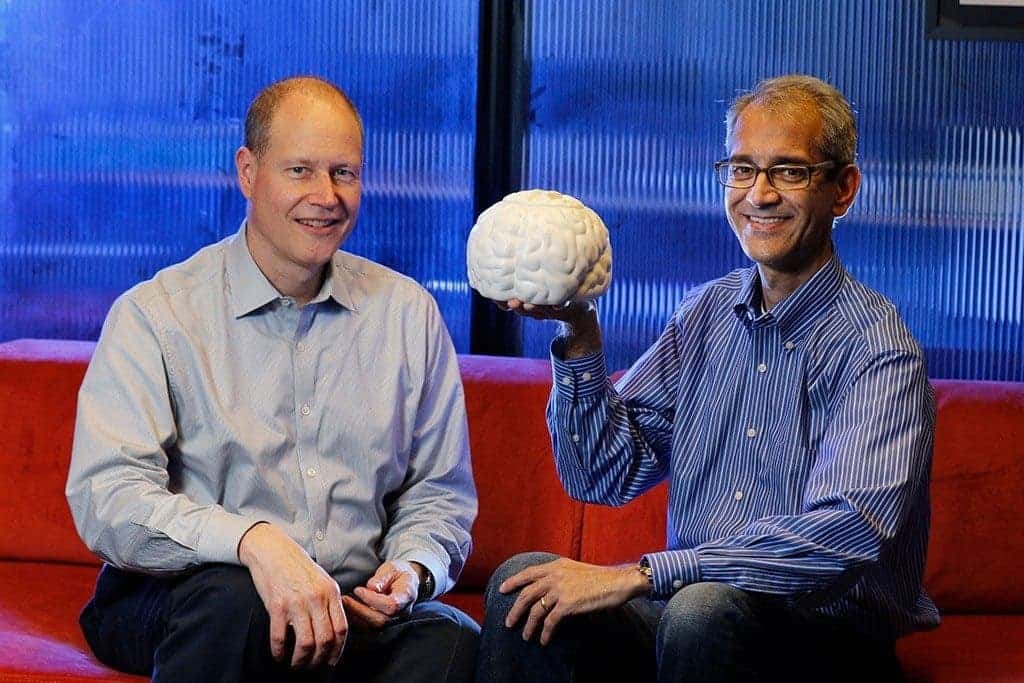Researchers from Stanford University demonstrated a novel brain-to-computer hookup that enables paralyzed patients to mentally type faster and more accurately than ever before.

Stanford’s Jaimie Henderson and Krishna Shenoy developed a brain-computer interface that allows the disabled to type with their thoughts faster than anything previously demoed. Credit: Paul Sakuma.
Some amazing things have been achieved with brain-computer interfaces — hardware that connects a patient’s brain directly to a computer which can process the signal it emits. These can be used by a completely paralyzed patient to move mechanical arms or exoskeletons, even drones. Such interfaces can also facilitate a telepathic-like exchange of information. But while controlling a mechanical arm or exoskeleton can mean a lot for paralyzed patients, such a solution isn’t readily available to anyone because the tech can be prohibitively expensive. Instead, BCIs whose role is to facilitate communication seem far more impactful.
There are various solutions available to patients with movement disabilities. The most common tools involve tracking the eye so just by looking at control keys or cells displayed on a screen, a user is able to communicate either by typing a message or selecting pre-programmed phrases. That’s sort of how Stephen Hawking’s type to speech computer works, albeit it’s based on muscle movements because he has drooping eyelids. But BCIs, which are more modern, promise to hands-free typing much more accessible.
The three participants who took part in the trial organized by Stanford all suffer from severe limb weakness. Two suffer from Lou Gehrig’s disease, and one from a spinal cord injury sustained in an accident. Unlike other BCIs whose electrodes are placed on the scalp or the surface of the brain, the present BCI was far more invasive. A baby-aspirin-sized electrode array was inserted inside the brain, right in the motor cortex, which is the brain region responsible for controlling muscle movement.
Electrical activity recorded in the motor cortex is transmitted through a cable to a computer where algorithms process the signal. Ultimately, the signal is translated into point-and-click commands guiding a cursor to characters on an onscreen keyboard.
After minimal training, each participant was able to outperform any previous brain-computer interface meant for enhancing communication. One participant, Dennis Degray of Menlo Park, California, was able to type 39 correct characters per minute, equivalent to about eight words per minute. Degray didn’t use any automatic word-completion assistance which would have significantly boosted his performance.
“This is like one of the coolest video games I’ve ever gotten to play with,” he said. “And I don’t even have to put a quarter in it.”
The advance of the new tech is two-fold. For one, the 100 electrodes that penetrate the brain to about the thickness of a quarter offered an unprecedented resolution. Secondly, the algorithm developed by Krishna Shenoy, PhD, professor of electrical engineering, and colleagues, is vastly superior to anything that preceded it. It was no trivial matter writing code that can convert the cacophony of complex electrical signals fired by nerve cells into actions typically executed by muscles or the spinal cord in real time.
“The performance is really exciting,” said postdoctoral scholar Chethan Pandarinath, who is one of the lead authors of the study published in the journal eLIfe. “We’re achieving communication rates that many people with arm and hand paralysis would find useful. That’s a critical step for making devices that could be suitable for real-world use.”
These results are the culmination of years of work under an international consortium known as BrainGate.
“This incredible collaboration continues to break new ground in developing powerful, intuitive, flexible neural interfaces that we all hope will one day restore communication, mobility and independence for people with neurologic disease or injury,” said Leigh Hochberg, a neurologist and neuroscientist at Massachusetts General Hospital and Brown University.









